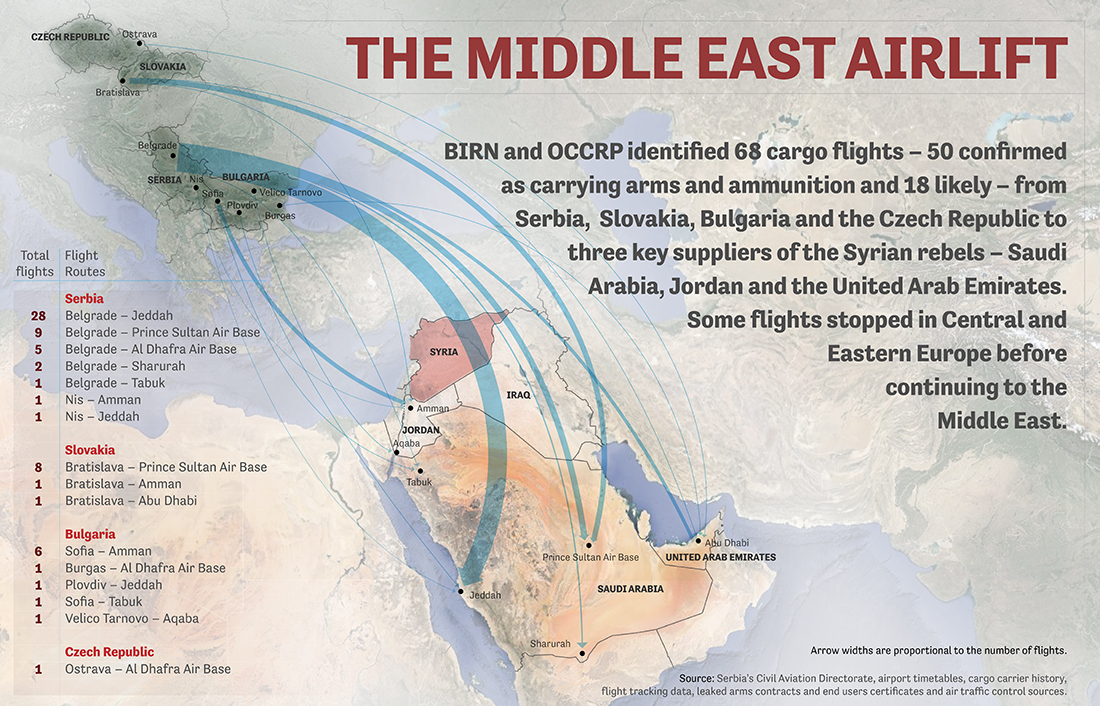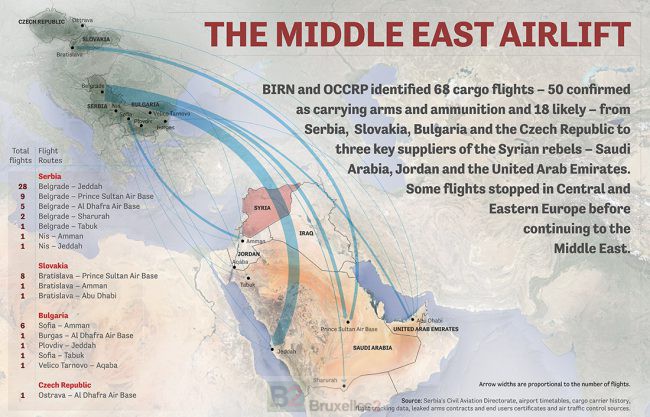Balkan Arms Airline. Well-organized traffic between the Balkans and the Middle East
(B2) From Belgrade or Nis, from Bratislava or Ostrava, from Sofia or Burgas... no less than 68 cargo flights loaded with weapons have come in the last 13 months to supply the conflicts in Syria and in the Gulf reveals a investigation conducted by several Balkan journalists. 50 of these flights are confirmed to be carrying weapons, 18 of these flights are " probably ". And these charters of a new kind do not seem new. Since 2012, our colleagues from the Balkans estimate that this highly organized trafficking has reached a value of at least 1,2 billion euros..
Very organized traffic
Looking more closely at arms export data, UN reports, theft records, and one-year arms contracts, these are thousands of assault rifles, mortar shells , rocket launchers, anti-tank weapons and heavy machine guns that left stocks and factories from Bosnia and Herzegovina, Bulgaria, Croatia, Czech Republic, Montenegro, Romania, Serbia and Slovakia. Destination: Syria via Jordan, Saudi Arabia, United Arab Emirates. Yemen and Libya would also be final destinations for the weapons, although to a lesser extent. To transport them, the most commonly used aircraft is the Ilyushin II-76. The advantage: it carries in its sides up to 50 tons of cargo, or about 16 AK-000 Kalashnikov rifles.
Well-organized purchases... via the CIA
These weapons, purchased by the Saudis, Turks, Jordanians and the United Arab Emirates are then routed through two secret command facilities - called Military Operation Centers (MOCs) - in Jordan and Turkey. These units coordinate the distribution of weapons to Syrian opposition groups selected by the Americans according to the Atlanta think-tank, the Carter Center. According to Robert Stephen Ford, American ambassador to Syria between 2011 and 2014, the CIA probably played an intermediary role between the Balkan countries (in particular Serbia, Bulgaria and Romania) and the Middle East for the sale of arms.
Americans on the front line
Journalists are quick to point out that the United States Department of Defense Special Operations Command (SOCOM) also procured and delivered large quantities of military equipment from Eastern Europe for the Syrian opposition as part of a " train and equip", worth $500 million. Thus, dSince December 2015, three cargo ships have transported 4.700 tonnes of arms and ammunition from the ports of Constanza (in Romania) and Burgas (in Bulgaria) to the Middle East. Probably within the framework of a clandestine delivery of arms to Syria ". The shipments would include heavy machine guns, rocket launchers and anti-tank weapons - as well as ammunition, mortars, grenades, rockets and explosives. The origin of the weapons delivered is unknown. The documents that the journalists were able to consult only giving information from stocks located in central and eastern Europe.
NB: It is mainly through social networks, in particular twitter and Facebook, that these weapons are then located at their final destination. A group of Kurdish soldiers, supported by SOCOM, published numerous photos showing a warehouse where boxes of ammunition are stacked, with the stamp made US.
A boom in sales since 2012
It is the conflict in Syria which is the main factor of this increase according to the authors of the survey. Prior to the Arab Spring in 2011, the arms trade between Eastern Europe and Saudi Arabia, Jordan, the United Arab Emirates, UAE, and Turkey - four main supporters of the Syrian opposition - was negligible, if not non-existent, according to the analysis made by the journalists. This changes in 2012.
Balkan factories are running at full speed
And the pace of transfers isn't slowing, with some of the biggest deals approved in 2015. arms manufacturing plants in Bosnia and Herzegovina and Serbia are running at " full capacity ", with additional equipment and other “no longer taking new orders ».
Over 1,2 billion orders
Since 2012, eight Eastern European countries have exported more than 829 million euros in arms and ammunition to Saudi Arabia, 155 million to Jordan, 135 million to the United Arab Emirates and 87 to Turkey. Only Qatar, yet a key supplier of military equipment to the Syrian opposition, is not in the export licenses from Central and Eastern Europe.
The figure is probably much higher, say the authors of the survey. " Arms export licensing data for four out of eight countries is not available for 2015 and seven out of eight countries for 2016.”
(transcribed by Nicolas Gros-Verheyde & Leonor Hubaut)
(1) Survey carried out by the Balkan Investigative Reporting Network - BIRN Kosovo and BIRN HUB - a team of journalists from all over Central and Eastern Europe which aims to " promote the rule of law, accountability and transparency in the Balkans and Moldova ". A project supported by the Austrian Development Agency (ADA).


1,2 billion transfers of arms and ammunition from Eastern Europe to the Middle East, obviously this is not negligible.
But for comparison…:
Over the same period (2012-2015), the Walloon Region alone exported 1,338 billion euros worth of weapons to Saudi Arabia (mainly light weapons), and that's not counting the giga-contract for CMI/General Dynamics armored vehicles via Canada.
Added to this (over the same period) 178 million to the UAE, 34 million to Turkey, etc.
Certainly there is a difference: while AK47s and other junk from Eastern Europe end up in the hands of various armed groups, Belgian hi-tech weapons tend to remain in the “legal” arsenals of buyers.
But both contribute to an irresponsible over-armament of the region.
This info is extremely interesting. It remains to be clearly determined whether this is illegal “trafficking” under international or European law (5 EU member states seem to be involved) – or exports that comply with legal standards but apparently concealed for reasons policies. JGG
To respond to JGG, about the EU member countries concerned: these are indeed exports considered “legal”, since they are apparently duly reported in successive EU COARM reports (see: http://www.grip.org/fr/node/542#coarm).
This clearly poses the problem of the highly variable interpretation of the EU's common position on the arms trade, and in particular the control of the final destination.